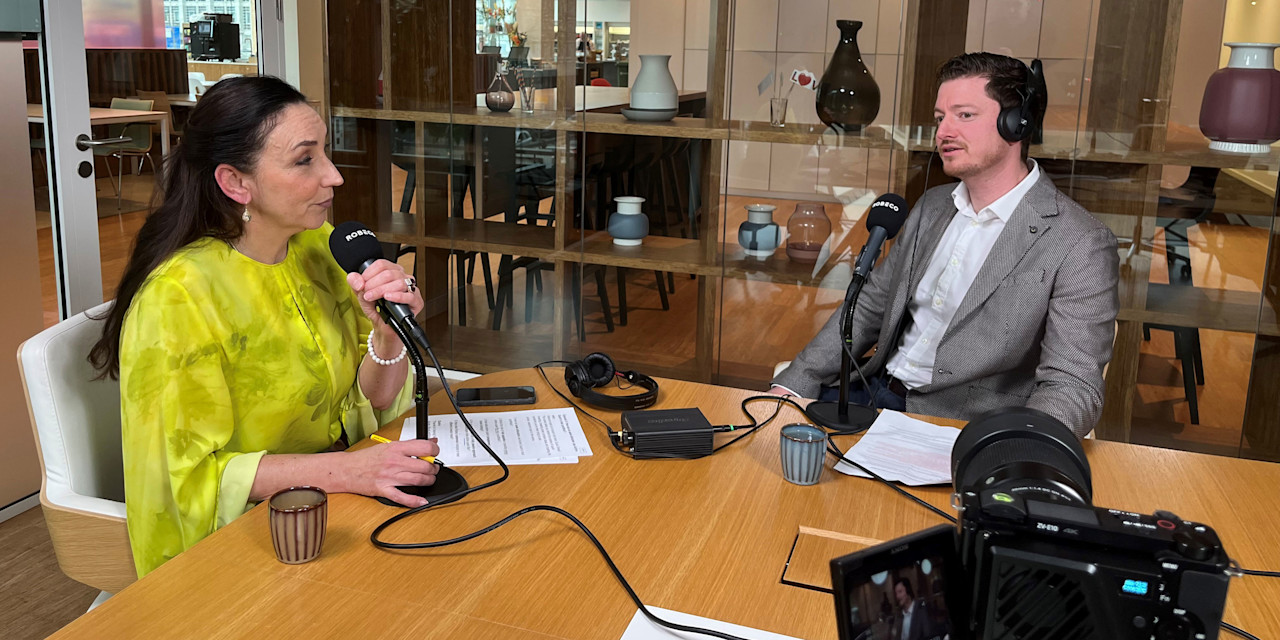
Podcast: The best is yet to come for factor investing
There were few places for investors to hide in 2022, as weakness spread across all asset classes. Factor investing strategies, by contrast, provided some refuge: their resilience in down-trending markets confirmed their comeback. So, it’s a good time now to take stock of what’s going on in the world of quant and factor investing. Tune in and listen to Weili Zhou, head of Quant Equity Research, and David Blitz, Chief Quant Researcher.

We do not guarantee the accuracy of this transcript.
This podcast is for professional investors only.
Erika van der Merwe (EM): There were few places for investors to hide in 2022 as weakness spread across all asset classes. Factor investing strategies, by contrast, provided some refuge. Their resilience in down-trending markets confirmed their comeback. So it's a good time now to take stock of what's going on in the world of quant and factor investing: what's changing and what are the future challenges? Weili Zhou is head of quant equity research at Robeco and David Blitz is Robeco’s chief quant researcher. Welcome to the show. Good to have you here.
David Blitz (DB): Thank you, Erika.
Weili Zhou (WZ): Thank you.
EM: David, the last time you were on this podcast – I had a look back – was in December 2020, which probably was the darkest phase of the quant winter at that stage. You discussed at that time why you expected the end of that dark season, and for it to come fairly soon. And you were right. So what's the state of factor investing today, given the recovery that then started in 2021?
DB: Yeah. So since the last time we spoke like this, factor investing had a really good run. So both 2021 and 2022 were very strong years. Basically, factor strategies recovered the losses in the prior two years – what we call the quant winter period – and reaching all-time highs again. Long-term track records are looking solid again. So yeah, I don't want to claim I'm a great market timer, but it was kind of spot on at that time.
EM: Now I know you don't like dwelling on the negative side of this and the pain of that, but looking back, was that a crisis of confidence, whether for your clients or for yourselves? But let's start on the client side. How did clients react? Did you see clients reacting to the poor performance and taking their money and running?
WZ: We absolutely see people were under stress and not only, let's say, from their own confidence, right? They also faced the pressure, for example, from their internal committee and asking the question: have you made the right call to allocate to factor premiums? So it's also a job risk for quite some of our clients. And I think it took really effort from both sides, from Robeco quant team, but also from our clients, their effort in understanding and helping to explain positioning as well as explaining the expectation to their broader beneficiary group or their internal committees. So that they could stand longer with us and go ahead with the journey. And of course, the message we also gave at that time is that, okay, if now you step out, that's really a bad decision, because then you would totally miss out to come back. And it's not sensible. And I think when you're…
EM: And you’re locking in the losses.
WZ: Absolutely. And this is what we see exactly happened in the last two years. That performance came back and many of our clients actually also went through the whole journey. And I think what we see is that their confidence and their understanding in this long-term nature of factor investing and the fact that factor premiums exist in the first place because of these emotional and, I would say, psychological challenge: you need to endure during difficult times. This is one of the reasons probably why factor premiums exist. And this is not easy or fun to see, but they understand much better after feeling it themselves.
EM: David, what about the emotion for you as an investor? Because even though you say you use algorithms, you're behind the keyboards, right? And I know you and your colleagues love the saying that I see you use: ‘Quant investing is more a test of character than a test of intelligence’.
DB: Yes. So obviously any period of underperformance makes you think again about every step of the process. You know, go back to every element in the design of the strategy. Like, you know, is this really doing what it should be doing? And so, by and large, we concluded that the design is sound and solid, although of course we also continue to evolve and incorporate new insights and make continuous enhancements. What we also did is put the realized performance into a historical perspective. And if you look a bit further back in time, you see that what we experienced in the quant winter period is actually remarkably similar to previous periods in the past. Actually, about every ten years there seems to be this exuberance phase because there's some new technological development or something which makes investors excited, forget about valuations, and then it seems that the models have broken down. And afterwards there tends to be a reversal again. And also history doesn't exactly repeat itself. But we do see that it rhymes a lot in this regard. So you can put it in perspective, learn also from those periods.
EM: Rob Arnott, the seasoned quantum investor from Research Affiliates, was recently asked what his key advice is for investors. And I think it really connects to what both of you have been saying. Have a listen.
Voice fragment: Don't chase performance. It's endemic. It's innate in the human psyche. The notion of: something's hurt me, get me out of here. Something's been good for me, given me profit, given me great joy. I want more of that. Even the quant community chases performance. Put together a bunch of factors in a multi-factor portfolio based on using the factors that had the best historical track record. Well, that doesn't mean they will have a good future track record. And so it's a form of, backdoor form of performance chasing, in a group that thinks they don't chase performance.
EM: That's Rob Arnott on the podcast ‘Excess Returns’. Any remarks, because he's also criticizing the quant community, accusing them of some behavioral biases.
DB: Yeah, so I think it's a fair point. Actually, I read this very recent piece from Arnott where he turns completely bullish on all factors. Seven years ago he was warning that you should be very careful because a lot of factors from a valuation perspective looked really expensive and nowadays he finds that it's actually the other way around. So he turned bullish on all the factors. And yeah, we agree with the valuation perspective. I don't think it's the only driver of factor returns that you should look at, but I agree with his view that factors nowadays have a tailwind from the valuation perspective.
WZ: I agree with David. And I think also if we look at what factor investing is equipped with nowadays, it's not only the backtests, the standard ones, but also there is a lot more empowered by machine learning, alternative data that could serve as augmenting elements and also help to explore not only the linear but nonlinear interaction among the factors. And I think with this valuation perspective, but also with the additional advanced statistical toolkit that we're able to maneuver, we're in a good time for the comeback of factor performance.
EM: So continuing the thought of you saying ‘in this difficult time’, really reassessing, questioning yourself, kicking the tires, are you still on the right track? Did that go as far back-to-basics as: are you still pursuing the right factors – or have you always kept to the same factors? And if so, why?
DB: Well, especially in the literature, there was a big debate about whether the value factor might have been dead. There were all kinds of articles with even ‘the death of value’ in the title. We didn't lose confidence in that particular factor to that extent, because we know that value has a 100-year track record also across multiple asset classes. So even a few bad years don't negate such a very strong long-term track record. It does make you think again about, you know, does value measure what we think it should be measuring. And if you look, for instance, at the academic definition, which is simply the book value to the market value of a firm, this makes a lot of sense for a traditional industrial firm with a factory and machines, etc. But if you think about a modern technology firm like Facebook, what's the book value, right? What are the tangible assets? So in that sense, you do need to update these metrics and bring them into the 21st century to make them equally relevant. So our research has been focusing on enhancing and then further evolving the factors. And we haven't given up on them at any point.
EM: But you’re still, then, with value, clearly, momentum, quality and low risk?
DB: Exactly.
WZ: And I think also one consideration we had during the reassessment of the whole process of turning every stone. One rule, actually, we sat together and said that, hey, we don't want to aim at repairing the last drawdown. That's not the purpose, because if you have the perfect foresight, perfect hindsight, then you know that you can always remove the drawdowns and make your backtest a perfect one. But that doesn't help you to be better positioned for the next drawdown. So we always say that, hey, if we look at whether it's such things, should we change or not, we intentionally would also do the robustness test by leaving out the periods, the most painful periods of the last, I don't know, 2 to 3 years, and say that if, even without this painful period up to 2017 or to some 2018, do we see the same benefit of making new choices or different choices? And I think this is crucial in safeguarding the robustness and making ourselves very resilient for the next drawdowns. Expect the unexpected in the forward context.
EM: Well, I think you're suitably warmed up now for the quiz. We prepared some quiz questions for you. Unfortunately, no tricky math questions because I know you can do them way better than I ever would be able to. These are just questions about your field, and we're looking for brief answers. So, first question: are you ready?
WZ: Yeah.
EM: Agree or disagree on this statement: “How factors are defined is less important than people think.”
DB: Disagree.
WZ: Disagree.
EM: Any reason why?
DB: Well, I see where that one is coming from. There's a paper by one of the other quant managers out there, who makes this argument And I see the reason for this argument. So in the short run, it doesn't really matter which value definition you use, if all value strategies are going down the drain or going through the roof. But in the long run, there's a huge difference in which kind of metrics you use.
WZ: Another example I would say is the residual momentum that we have, right? So if you compare it to the traditional textbook momentum, is just taking out the exposures that are time varying. But then it really offered huge protection for us, at least during the turn of the market. And this is not something that you see on an everyday basis, but it's an airbag that's offered cushion during the exact moment that you need it. So I would say, yeah, maybe it's a one-out-of-ten-year events, but you will have this airbag in place and most of the time you won't have a feeling, but it's there for you.
EM: Next question. True or false? “Factors can be timed.”
DB: Partially true.
WZ: Difficult after trading costs.
EM: And therefore you don't?
WZ: I would still have some reservation saying yes.
EM: Next question. Complete the sentence: “The value factor works because…”
WZ: …of behavioral biases of investors.
DB: Because people overpay for growth, structurally.
EM: Excellent. So, next question. True or false? “Factor diversification, that is, multi-factor strategies, are an effective investment strategy.”
DB: Agree.
WZ: Not enough if you look at the traditional generic versions of it.
EM: Explain?
WZ: Because I think if you only count on a number of, I would say two, three or four factors, that might not be sufficient. It doesn't offer you protection and diversification at any given moment. So it can be an extended period that you don't have much diversification benefits. But if you extend your investment horizon and if you blend it with even more factors or signals, that might be short term in nature but can be stable or complimentary drivers of the performance during the time of lack of diversification for the traditional factors, I think that would be a more robust strategy for investors.
EM: Bonus question to end with. It's slightly tricky, perhaps: Which single factor do you believe has the most potential right now, given market conditions?
DB: Still value.
WZ: Well, I invest myself in low volatility strategies, so I think that actions speak louder than words.
EM: There you go. Looking to the future, what's the future of factor investing? David, you were right at the end of 2020, when you said the quant winter would soon end. Now, two years on, you've published a paper in the newest edition of the Journal of Portfolio Management. It's entitled “Factor Investing: The best is yet to come”. So, what precisely is to come?
DB: Well, the best. So this title was also a bit provocative and also meant, especially for investors who started with factor investing just prior to the quant winter. So we have a lot of clients who are long-term clients who have been through various ups and downs, but especially the ones who started more recently and well, now they made a strong comeback in the last two years, but still, the best is still to come for them. Besides that, there's this whole revolution going on in the quant world with lots of data becoming available, lots of computational power becoming available, that quants didn't have before. So, yeah, big data, machine learning is offering massive opportunities and making the field super exciting again.
WZ: Yeah, and I think ‘the best is yet to come’ is not only for factors but also for active, more specifically, for active factor investors. Because if you look at the trends in the past, a lot of money flowed into passive indices. But given the new development, that there is more and more requirements and need for sustainability integration, even passive investing is becoming more active. Supposedly you have a very long exclusion list, right? Which benchmark would you choose? How would you make it passive if you start with so many active choices in the first place with index providers as flexible as you wish for, right, to adapt towards your evolving sustainability-integration wishes. So all this actually is making it very interesting for active factor investing or sustainability integration to play a bigger role going forward.
EM: What progress are you making with sustainability integration and perhaps – I don't know how related the question is – is sustainability or ESG a factor?
DB: On the one hand, you've got these standard ESG scores from well-known providers, which are like composite scores, where a lot of information is blended together. They have been criticized a lot in the market, because if you look at the ratings from the different providers, there's actually very little correlation between these metrics. So if one says it's a great firm, the other can say it's not a good firm based on ESG. What we do nowadays is to look much deeper. So, for instance, one of the things we've been looking at within the environmental dimension of ESG is resource efficiency. So, how resource efficient is a firm compared to its peers. On a social dimension you can look at whether employees are happy with a firm. There's also data available nowadays where we can measure that. So, you know, within ESG, we're digging a lot deeper and looking at very specific signals where there's an economic rationale. So where there could be a relation with subsequent returns. And there we find that indeed this is offering valuable new alpha signals.
WZ: Yeah, I would say the environmental, social and government aspects also reflect the quality of a company in the long run. And alternative data is giving the strong edge in this aspect. They are making us having better, earlier insights into these type of quality aspects. And therefore some really showed significant alpha, additive alpha, with strong t-stats. And therefore we also see those signals as pecuniary signals, that really matter for the risk and the return profile of a company – financial risk and the return profile of a company – in the long run.
EM: And then, more existentially, if you look at the outlook for factor investing as a discipline… Let's first listen to this observation from Jennifer Bender from State Street.
Voice fragment: Over the last five years, we've seen a lot bigger year-to-year variation in the performance of factors than we saw, say, between 2000 and 2015, for instance. So, you know, between 2016, ‘17, ‘18, you saw these huge outperformances of quality stocks and momentum stocks, then reversals. And if you look at the spreads between the worst and the best-performing factors, these were larger than ever, which is really interesting, right? It does suggest that something has changed fundamentally about factor investing. But again, echoing what everyone else has said, still extremely important if we care about return generation and risk mitigation.
EM: Jennifer was speaking as a guest of the Frank Fabozzi webinar on the platform ‘Portfolio management research’. Weili, I see you recognized that. I find it interesting, Jennifer talks about, she says something's changed, but then she was very quick to draw it back to say, well, it's still relevant in managing risk. Your reaction to this?
WZ: Well, I think the huge spread that she mentioned among factors, in a way, it is also related to the extreme or large negative correlation among the factors. And in a way, also, it reflects the lack of diversification that we see of factor performance during that period. Because if the factors are very well diversified, you might not be able to see such big dispersion. While, if quality acts very, very positive while value extremely negative, and the other way around, I think it's just showing that the long-term correlation that we observe among factors do not seem to apply to the factors during this specific period of time. And it actually goes all the way back to the question of what kind of diversification do we expect among factors, and should we always expect them to be perfectly diversifying each other? And I think the last couple of years proved that that's not true. And we should have very realistic expectations that, hey, sometimes they would be crowded or even having three factors on one side, while the other one is left on the other side.
EM: David, final brief remarks for you on this point, but also specifically, then, referring to the outlook for the discipline.
DB: Yeah. So I agree that factors in the last couple of years have been a lot more volatile than in the period directly before that. At the same time, if you go back a bit further in time, so taking the tech bubble of the late nineties and the collapse of the tech bubble afterwards, it's actually quite similar. So this factor of volatility goes in waves. So sometimes factor volatility is elevated and then there's a more quiet period again. I think we've just been through this period of upheaval with elevated factor volatility. And now that we have seen this exuberance period and the reversal again, I think everything is set for a more normal period again. So factors showing more normal behavior. The macro environment has also normalized, if you look at the zero interest rates or the negative interest rates which have disappeared. So that also makes me say that the best is yet to come for factors!
EM: David, Weili, thank you so much. Good job. And to listeners, thanks for being part of this conversation. If you've enjoyed the show, please rate the Robeco podcast on the platform from which you're listening. We'd love to hear from you, so please send us your comments, feedback and suggestions to podcast@robeco.com. You'll find all our podcasts on your favorite podcast platform as well as on the Robeco website.
Voice: Thanks for joining this Robeco podcast. Please tune in next time as well. Important information. This publication is intended for professional investors. The podcast was brought to you by Robeco and in the US by Robeco Institutional Asset Management US Inc, a Delaware corporation as well as an investment advisor registered with the U.S. Securities and Exchange Commission. Robeco Institutional Asset Management US is a wholly owned subsidiary of ORIX Corporation Europe N.V., a Dutch investment management firm located in Rotterdam, the Netherlands. Robeco Institutional Asset Management B.V. has a license as manager of UCITS and AIFS for the Netherlands Authority for the Financial Markets in Amsterdam.
Beschikbaar op





























